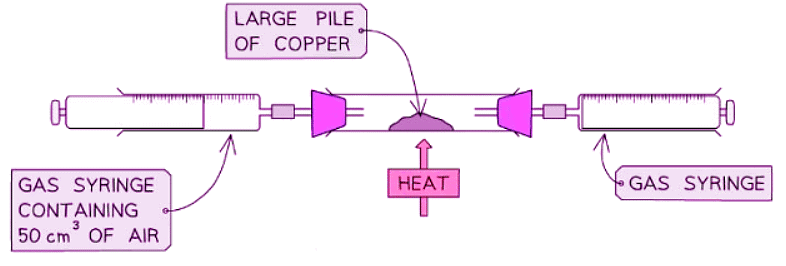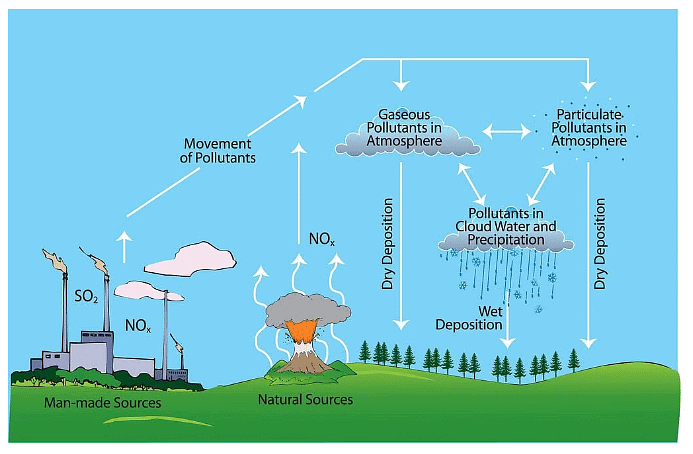Class 10 Exam > Class 10 Notes > Chemistry for GCSE/IGCSE > Air and Air Pollutants
Air and Air Pollutants | Chemistry for GCSE/IGCSE - Class 10 PDF Download
The Composition of Air
- The chart below shows the approximate percentages by volume of the main gases in unpolluted, dry air:

Uses of air
- Various gases found in the atmosphere serve crucial purposes across different industries.
- Noble gases find diverse applications; for instance, helium is utilized to inflate balloons, argon is employed in tungsten light bulbs, and krypton is utilized in lasers used for eye surgery.
- Oxygen plays essential roles in steel production, welding processes, and respiratory equipment.
- Nitrogen finds applications in food preservation through packaging, ammonia production, and the manufacturing of silicon chips.
- Oxygen and nitrogen are separated from atmospheric air through a process called fractional distillation.
The Composition of Air
- The following data illustrates the approximate proportions of key gases in clean, dry air:
- Nitrogen: About 78%
- Oxygen: Roughly 21%
- Argon: Close to 1%
- Other gases like carbon dioxide, neon, helium, and methane make up the remaining small fraction
Question for Air and Air PollutantsTry yourself: Which gas is primarily used in the production of steel and welding processes?View Solution
Investigating the Percentage of Oxygen in Air
- The percentage of oxygen in the air can be determined by passing a specific amount of air over a metal.
- When air is passed over the metal, the oxygen present in the air reacts with the metal, leading to the formation of a metal oxide.
- As a result of this reaction, the oxygen is extracted from the air, and the remaining volume of air without oxygen can be measured.
- An apparatus, such as the one depicted in the image below, can be utilized to carry out this investigation.
Example Apparatus

Method
- Heat the copper using a Bunsen burner
- Push the plunger of the syringe containing air, forcing the air into the other plunger until all of the air has transferred
- Push the air back from the now filled plunger to the other plunger
- Repeat this several times for about 3 minutes
- The copper will turn black as copper reacts with the oxygen in the air and copper oxide is produced
- Allow the apparatus to cool
- Ensure all the gas is in one syringe and record the volume of gas
Air Pollution
- Air pollutants are additional gases in the atmosphere due to human activities, beyond those naturally present.
Carbon Dioxide
- Carbon dioxide arises from the complete combustion of carbon-containing fuels like fossil fuels, e.g., methane combustion:
- Equation: CH4 + 2O2 → CO2 + 2H2O
- Adverse effects: It contributes to global warming, leading to climate change.
Carbon Monoxide
- Carbon monoxide results from the incomplete combustion of carbon-containing fuels such as fossil fuels, e.g., incomplete gasoline combustion:
- Equation: C8H18 + 9O2 → 5CO + 2CO2 + 9H2O
- Adverse effects: It is toxic, binding with hemoglobin in the blood, hindering oxygen transport.
Particulates
- Sources of particulates include the incomplete combustion of carbon-containing fuels like fossil fuels, resulting in the production of carbon particulates (soot). For instance, the incomplete combustion of methane can generate carbon monoxide (CO) and carbon (C).
2CH4 + 3O2 → 2CO + 4H2O
CH4 + O2 → C + 2H2O - Adverse Effects: Particulates can lead to respiratory problems and are linked to cancer development.
Methane
- Methane is sourced from waste gases in the digestive processes of animals, decomposition of vegetation, and bacterial activity in swamps, rice paddy fields, and landfill sites.
- Adverse Effects: Methane contributes to global warming, consequently leading to climate change.
Oxides of Nitrogen
Oxides of nitrogen encompass various nitrogen compounds with oxygen, often produced during combustion processes.
- Sources of Nitrogen Dioxide:
- Occurs from the reaction of nitrogen with oxygen during high-temperature processes like in car engines, furnaces, lightning, and bacterial activity in soil.
- Adverse Effects of Nitrogen Dioxide:
- Results in the formation of photochemical smog.
- When dissolved in rain, it forms acid rain, leading to corrosion of metal structures, buildings, statues made of carbonate rocks, harm to aquatic life, crop contamination, and pollution of water supplies.
- Causes irritation to respiratory organs (lungs, throat, eyes) and respiratory issues.
Sulfur Dioxide
- Sources: Combustion of fossil fuels containing sulfur compounds, particularly prevalent in power stations.
- Adverse Effects: Dissolves in rain to form acid rain, exhibiting similar damaging effects as the acid rain caused by nitrogen oxides.
 How acid rain is produced
How acid rain is produced
Question for Air and Air PollutantsTry yourself: What is the adverse effect of carbon monoxide?View Solution
The document Air and Air Pollutants | Chemistry for GCSE/IGCSE - Class 10 is a part of the Class 10 Course Chemistry for GCSE/IGCSE.
All you need of Class 10 at this link: Class 10
|
72 videos|162 docs|61 tests
|
FAQs on Air and Air Pollutants - Chemistry for GCSE/IGCSE - Class 10
| 1. What is the composition of air? |  |
Ans. Air is composed of approximately 78% nitrogen, 21% oxygen, and small amounts of other gases such as argon, carbon dioxide, and water vapor.
| 2. What are the uses of air? |  |
Ans. Air is used for respiration by living organisms, as a medium for transportation of sound, as a source of oxygen for combustion, and in various industrial processes.
| 3. How can the percentage of oxygen in air be investigated? |  |
Ans. The percentage of oxygen in air can be investigated by conducting an experiment where oxygen is absorbed by a substance such as copper and the remaining gas is nitrogen, which can be measured.
| 4. How is the percentage of oxygen in air calculated? |  |
Ans. The percentage of oxygen in air can be calculated by dividing the volume of oxygen by the total volume of air and then multiplying by 100 to get the percentage.
| 5. What are some common air pollutants that contribute to air pollution? |  |
Ans. Some common air pollutants include particulates, sulfur dioxide, nitrogen oxides, carbon monoxide, and volatile organic compounds, which can have harmful effects on human health and the environment.
Related Searches




















